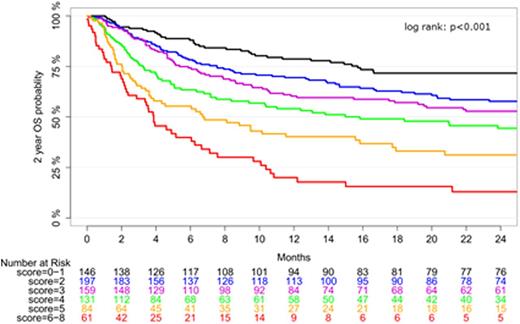Abstract
Background: Prognostic scoring systems for allogeneic stem cell transplantation (HSCT) are of clinical value when determining a leukemic patient's suitability for this curative, but risky, procedure. Several such scores have been developed over the years for HSCT from sibling or unrelated donors, but no predictive score has been developed specifically for umbilical cord blood transplantation (UCBT). Although individual parameters have been identified to be associated with UCBT outcomes in acute leukemia (AL) patients, integrative tools for risk evaluation in this setting are lacking. We sought to develop a prediction model for overall survival (OS) (primary objective) and leukemia free survival (LFS) (secondary objective) at 2 years following UCBT in acute leukemia patients.
Methods: A retrospective, international registry-based study, of 3140 acute leukemia patients who underwent UCBT from 2004 through 2014. Inclusion criteria were patients with AL receiving single or double cord blood units transplantation. Median follow up was 30 months. The dataset was geographically split into a derivation (65%) and validation set (35%). A Random Survival Forest was utilized to identify predictive factors. Top predictors were introduced into a Cox regression model, and a risk score was constructed according to each variable's hazard.
Results: The median age at UCBT was 21.9 years. The 2 years OS rate was 47.7% (95% CI: 45.8-49.6). After identifying the top predictive variables, the UCBT risk score (Table 1) was constructed using 9 variables (disease status, diagnosis, cryopreserved cell dose, age, center experience, recipient cytomegalovirus sero-status, degree of HLA mismatch, previous autograft and anti thymocyte globulin administration). Over the derivation and validation datasets, a higher score was associated with decreasing probabilities for 2 years OS and LFS, ranging over the validation set from 0.72 (0.64-0.8, 95% CI) and 0.68 (0.6-0.76, 95% CI) to 0.13 (0.06-0.27, 95% CI) and 0.14 (0.07-0.28, 95% CI), respectively (Figure 1). An increasing score was also associated with increasing hazard of the predictive outcomes (Table 2). The score's discrimination (AUC) over the validation set for 2 years OS and LFS was 68.26 (64.25-72.27, 95% CI) and 66.95 (62.88-71.02, 95% CI), respectively. Calibration was excellent.
Conclusion: We have developed the first integrative score for prediction of overall survival and leukemia free survival in acute leukemia patients undergoing a UCBT. The score is simple and stratifies patients into distinct risk groups.
Association between the UCBT risk score and 2 years OS and LFS over the validation dataset
Association between the UCBT risk score and 2 years OS and LFS over the validation dataset
Overall survival stratified by the UCBT risk score over the validation data set
Bader:Servier: Consultancy, Honoraria; Neovii Biotech: Research Funding; Riemser: Research Funding; Medac: Consultancy, Research Funding; Novartis: Consultancy, Honoraria.
Author notes
Asterisk with author names denotes non-ASH members.




This feature is available to Subscribers Only
Sign In or Create an Account Close Modal